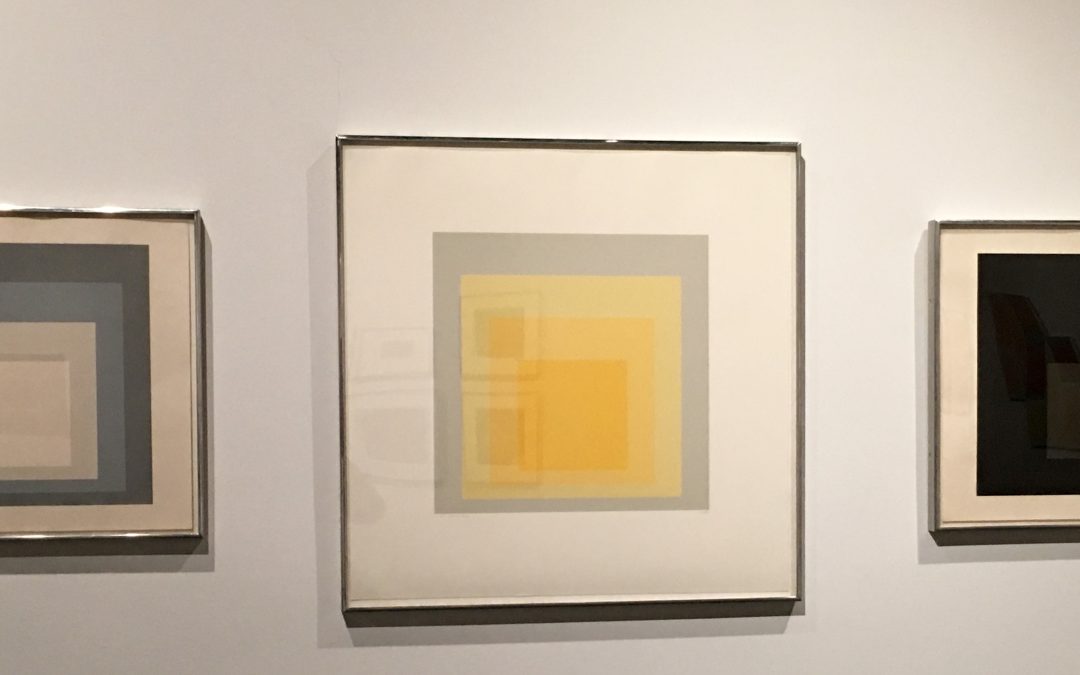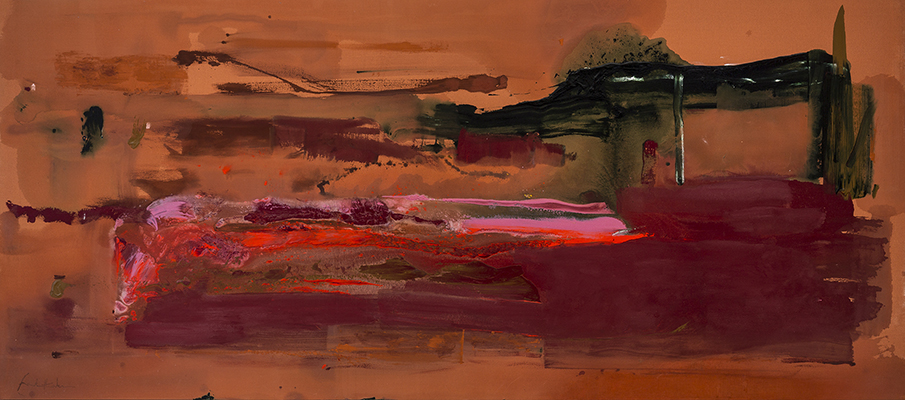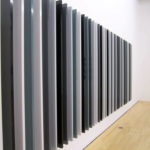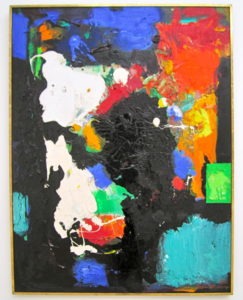Every so often, a fragrance saunters into the market, demanding our attention with an air of undeserved audacity. Jean Paul Gaultier's Divine (2023), however, feels less like a sophisticated, daring entry and more like a grandiloquent crash. Its limited notes of...

Never Mind the Pollocks Here’s the Bauhaus
Never Mind the Pollocks Here’s the Bauhaus
This article originally appeared with the title Fear of a Black Mountain: Tampa Museum of Art’s Elevation of Abstract Expressionism in the 24 May 2019 edition of ArteFuse.
There is a formidable father figure hovering over the powerful double exhibition of broadly-defined Abstract Expression at the Tampa Museum of Art, just not the one some seemed to be expecting. Rather – and appropriately given that this year marks the 100thanniversary of the Bauhaus – it is Josef Albers whose spirit dominates. Exacting, meddling, and critical, yet so inseparable from his own theoretical concerns as to be cold and distant, it is the students – damaged, rebellious, reverent, brilliant – of Albers and their patrilineal inheritors who are the stars of this show. Albers, who, upon being uprooted from his role as handicrafts master at the Bauhaus Dessau in 1933 immediately became head of the painting school at Black Mountain College, also forcefully reminds us that modern and contemporary art, and its presence in museums, is a shared international terrain that should be marked by continuity, not competition. Even artists not engaged in comparable processes of production must, in this time when it has become fashionable to repudiate the “moment of Modernism,” recognize this import network of systems and influences that traces its origins to fin de siècle Munich, then radiates from North Carolina to the Eastern Seaboard.
To be clear, this is my reception of the paired shows at the Tampa Museum of Art, which are intended as a celebratory retrospective. Despite the name-embedded implications of one, Abstract Expressionism: A Social Revolution Selections from the Haskell Collectionit is the pre-colon title of the other, Echoing Forms: American Abstraction from the Permanent Collectionthat better captures the spirit of this superbly curated and installed grouping of works. In fact during the time we tend to think of as “peak AbEx” – the years between Jackson Pollock’s 1947 Full Fathom Five and 1952’s Convergence Abstract Expression was anything but revolutionary. Pollock and his drip-pour paintings had been successfully apotheosized by patrons and champions Peggy Guggenheim and Clement Greenberg. The Wyoming native was further catapulted to art-stardom by the exaggerated creation myth of Mural (1943) and Hans Namuth’s adoring short film Jackson Pollock 51. Pollock appeared in cover stories in Life magazine hanging out with Alfred H. Barr and the buttoned-down board of Manhattan MoMA. It doesn’t get much less revolutionary than that.
This however is a boon to the show at the TMA. Both Social Revolution and Echoing Forms are mercifully devoid of Pollock, and minus his suffocating figure, we see clearly the underestimated quest for freedom and honesty of sensation of other artists working to test the limits of the embodied painting process.
The intelligent hanging of the show offers guidance for first-time encounters as well as clever subtexts. In one of the Echoes galleries, a set of serigraphs and silkscreens by Albers faces a series of silver gelatin prints by Black Mountain alumni Aaron Siskind, who would become an art professor himself. Each set was made over decades. Albers sought the nondescript form of the square to elaborate on his colour theory, using repetition to create abstract art without a subject or context outside formal constructions. Siskind photographed quotidian objects – gym equipment, paint peeling from walls, wrought iron gates – in such a way as to erase their recognizable meaning. Pattern repetition is important to both Albers and Siskind, but the curatorial stroke of placing the series together is suggestive of Jeff Wall’s conception of photographic tableaux as a paradoxical means of reclaiming the primacy of painting – an idea this grouping seems to refute.

Above: Josef Albers, Day and Night I, 1963, serigraph; I-S LXXIII, 1973, silkscreen; Midnight and Noon I, 1964, serigraph.
Right: Aaron Siskind, Morocco 49, 1982; Martha’s Vineyard 2, 1952; Westport 73, 1988; Salvador 82, 1984; Salvador 16, 1984; Salvador 81, 1984; all silver gelatin prints; Tampa Museum of Art permanent collection. Photos: Jean Marie Carey


The radiating scarlet of Albers’s tiny 1964 Study for Homage to the Square shows his effort to control perception through a focus on colour. Placed on a supporting wall next to the enormous rod- and cone-searing high-intensity Temple to Royal Green (1983), Homage [both to left] holds its own. Templeis the work of one of Albers’s students, Richard Anuszkiewicz, who applied the brilliant paint in the geometric configurations of the square to entirely different effect. Practically pulsating off the canvas, the combination of colour, lines, and shape challenge the teacher’s controlled experiment by revealing the instability of our perceptions of stillness and movement, contrast and complement.
A work seen for the first time fascinated me for hours. Kenneth Noland, a North Carolina native, attended Black Mountain College with three of his brothers and was intrigued by the stories Albers told of the Bauhaus, drawn particularly to the work of Paul Klee. Noland was classified in the “post painterly abstraction” movement of the 1960s, working in the soak-stain technique associated with Colour Field before arriving at the shaped canvases he is best known for today. Summer’s Gold (1983), though making use of Noland’s signatory chevron, does not easily fall into any of those categories. The nested “V” shapes in green, white, and yellow with a wedge of black are bled into by patches of violet and pink. Erratic, energetic impasto creates an opposite sense of soothing. In looking more closely at the grey space on the canvas and the application of the paints, I eventually realised Summer’s Gold’s acrylics are layered over another painting, giving it the nostalgic feeling of a fading sign slowly disappearing from a building, even as the still-bright arrow-angles maintain definition of line.
The placement of the Noland next to Frank Stella’s New Caledonian Lorikeet (1980) is the exhibition’s best juxtaposition. An extension of Stella’s “Exotic Birds” series begun in 1977 as Stella became more interested in both printing and three-dimensional work, Lorikeet’s gestural animation meshes with Summer Gold’s rich texturing. Taken together these works reinforce the notion that abstraction, in its original meaning, is a form of radical simplification with direct references to the physical world.


Above: Kenneth Noland, Summer’s Gold,1983. Below: Viewers take in the best juxtaposition of the exhibition, Kenneth Noland, Summer’s Gold,1983, left, and Frank Stella, New Caledonian Lorikeet, 1980. Photos: Jean Marie Carey.
The narrative characteristics of other works offer counterpoints to the misuse of the term “abstraction” to which this genre is particularly susceptible. One such assemblage (which I am astonished to see in Tampa) is Gerhard Richter’s Abstract Painting (613-3), 1986. Created just before Richter’s 18 Oktober 1977 series, Abstract Painting is composed of photographed sketches of brushwork then transferred to the canvas. Joan Mitchell’s diptych Aires pour Marion (1975-1976) feature’s Mitchell’s characteristic touches of patterned oil paint. The left panel is primarily orange and reddish earth tones with blue underpainting; the right side reverses the palette as a dark blue rectangle looms up from the bottom left corner. Perhaps this is the space referenced in the title of the painting.
One of the joys of the Social Evolutionpart of the show is that these pieces come from the private collection of Jacksonville builder Preston Haskell and thus have rarely been seen in public museums spaces. Another favourite discovery was Sam Francis’s Untitled (1988-1989). The painter’s use of layered acrylic techniques, contrasting colors surrounding two blue-green whale-shaped forms, and a crisp white background, create incredible depth and gives the painting the three-dimensional presence of a sculptural object.
The exhibition also offers opportunities to jostle some pedestals. I have always thought Willem de Kooning (who fled Black Mountain College, leaving Elaine de Kooning there to finish the lessons that would lead to her greatly under-studied body of portraits, landscapes, and collection of art criticism) was not in the same league as many of his contemporaries – Robert Rauschenberg improved de Kooning’s work by erasing it, after all. Woman II(1961) is another of de Kooning’s flattened women, an oil painting de Kooning somehow makes look like a sketch.

Above: Willem de Kooning, Woman II, 1961. Oil on paper mounted on canvas. The Haskell Collection. © 2018 The Willem de Kooning Foundation / Artists Rights Society (ARS), New York

Right: Morris Louis, Pillars, 1962. Photo: Jean Marie Carey. Above: Helen Frankenthaler, February’s Turn, 1979. Oil on canvas. The Haskell Collection. © 2018 Helen Frankenthaler Foundation, Inc. / Artists Rights Society (ARS), New York
Having recently re-readMichael Fried’s high-spirited defense of a show at New York City’s Mnuchin Gallery of Morris Louis’s Veils (responding in full Fried “T.J. Clark takedown” form to a comment by The New Yorker’s Peter Schjeldahl that Colour Field Painting was “lightweight” along with the insinuation that viewers had to be drunk to enjoy it)[1]I was, as a fellow Louis fan, especially curious to see a work at the TMA from the last phase of Morris’s career, Pillars (1962). Louis had worked on a series of themed works called the “stripe paintings” through 1960 and 1961, several with the word “pillar” in their titles (Pillar of Delay, Pillar of Celebration), extreme vertical monoliths in variables of delineation and opacity. Louis was diagnosed with lung cancer in the spring of 1962 and died that September; Pillars would have been one of his final works. How potentially poignant! Instead Pillars, a cascade of autumn olives, oranges, and golds on an ecru unfurled, finds Louis as unflustered and methodical as ever, in what was perhaps a moment of respite. February’s Turn, Helen Frankenthaler’s adjacent work from 1979, is a last blast of shades of fresh and dried blood, a last gasp before Frankenthaler retreated to the stained-glass forms of her late career. Frankenthaler’s and Louis’s paintings, like each work in the show, is not an answer but an atmosphere, an out-of-time event, in every sense of the expression, meant to be inspected and contemplated.
[1]Michael Fried, “Morris Louis: Veils,” ArtForum, December 2014, pgs. 266-269.

Louis, along with Noland, helped found the Washington Color School which was active during the 1950s-1970s. One of the TMA’s great treasures from its own collection is by a member of this group. Alma Thomas made New Galaxy in 1970. This intriguing painting has a celestial name, but its cascade of blue tiles with a pale peach border also suggest an incoming tide, or a hopeful, Blakesian view of a “New Galaxy” on earth, seen from above. Thomas, who was the first graduate of Howard University’s fine arts program, had spent her life as an educator in addition to her lifelong pursuit of abstraction; through the 1960s Thomas organized civil rights marches and protests against the war in Vietnam.
While Thomas was collaborating with Albers’s student Noland, across the ocean, two more Black Mountain alumni – John Cage and Merce Cunningham – profoundly influenced another social revolution, Fluxus, which brought together black American double-bassist Ben Patterson, Korean performance and technology art pioneer Nam June Paik, established Düsseldorf provocateur Joseph Beuys, and atelier organizer Mary Bauermeister. Rather than Cage’s notes of nothing, this environment was punctuated by the continuous tone of each generation’s semi-successful art academy jailbreak. Almost all ended up as both artists and educators, Albers’s’ children as parents of the women and men of the neo-avant garde.
These complicated influences and interactions can only be disentangled in hindsight, and there is much we have yet to learn about art in the 20thCentury, for its own sake and to inform our understanding of artists’ concerns in the 21st. Yet several prominent museums have ceded to popular demand to divest from AbEx, with SFMoMA’s declaration to put Mark Rothko’s monumental Untitled(1960) on the block at Sotheby’s this month, the anticipated $50 million sale earmarked to diversify the collection. MoMA NYC will close for the summer, opening in the fall with thematic galleries featuring a pared down Modernist roster. William Poundstone, founder of the blog Los Angeles County Museum on Fire, pored over the 600-page-plan for an architectural expansion of LACMA only to discover that the project actually reduced the museum’s gallery space by 110,100 square feet, intending to eliminate the museum’s permanent displays in favor of rotating exhibits emphasizing trendy topics.

Above: Alma Thomas, New Galaxy, 1970. Tampa Museum of Art, Gift of Douglas H Teller in memory of Julian H. Singman, 1997.017.
The Tampa Museum of Art’s Abstract Expressionism: A Social Revolution Selections from the Haskell Collectionon view through 11 August 2019 and Echoing Forms: American Abstraction from the Permanent Collection; Farish Gallery, on view through 28 July 2019; Saunders Gallery on view through 18 August 2019. Catalogue: Joanna Robotham, Valerie Hellstein and Michael A. Tomor, Abstract Expressionism A Social Revolution Selections from the Haskell Collection (Tampa: Tampa Museum of Art, 2019); 56 pages with 24 colour plates and other illustrations.
Though the curators and benefactors of the Tampa Museum of Art tend to remove themselves from these controversies and Social Revolution/Echoing Forms has been long in the works, it is serendipitously timed as a reminder of the importance of history in art history. Further this group of paintings reinforce how under-representative reproductions of artworks in print or on the computer screen are of the real thing. It is stunning how much of the experience of the paintings shown in this article are missing when viewed only as photographs. In person many of these works are mesmerizing, and the TMA’s white-walled second-floor galleries and austere high ceilings are made for Abstract Expressionism. The curators have succeeded in presenting a part of the canon of Modern art some would like to turn over to social justice Savonarolas as a matter of vital and important contemporary interest.
RECENTLY ON MICHELANGELOST™...
Gaultier’s Dubious Divinity: A Troma Tragedy
Norwegen Blumen / Norway Flowers I
Norway Flowers / Norwegen-Blumen I
Eden and Everything After
From: 21 January 2023-21 December 2023 Opening: 21 January 2023, 14:00 University of Stavanger Archaeological Museum Peder Klows gate 30A 4010 Stavanger Norway Hours: Tuesday 11 – 20 Wednesday – Sunday 11 – 16 Monday closed....




